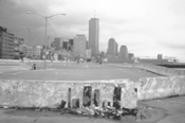Curator Kristin Chambers has assembled a group of artists in whose work she sees a thoughtful response to technological overdose. To her credit, the show is not a tribute to technophobia. The Unabomber was a destroyer, not a creator. As he railed against the high-tech world, he was maiming and murdering. This show is not about rejecting technology. Rather, as Chambers has conceived it, it is a record of how contemporary artists find their own way, literally and figuratively, in an increasingly complex world. In other words, the interest is not in polemics, but with what Harvard anthropologist Stephen Jay Gould has called "the great mental strategies that we use to wrest order and meaning from a recalcitrant world."
One can see this impulse in the work of Mexican artist Gabriel Orozco. His richly suggestive 1993 photograph "Island Within an Island" depicts a temporary sculpture made by the artist from litter and pieces of board set against the imposing Manhattan skyline. Orozco contrasts impermanence with permanence, texture with form. In constructing his own miniature version of the city, he is humanizing it for his own benefit. One thinks, in this context, of that witty set of photographs (not in this show) by American Duane Michals in which he shows himself in front of the great pyramids at Giza. He then proceeded to build a miniature replica of the site with stones. By doing so, he was personalizing what the history books had impersonally called a "wonder of the world." In both instances, the idea is to take something that inspires fear or awe and re-create it in an effort to understand it better.
By contrast, Peter Land, a Danish artist, is a prankster. His video "The Staircase" takes on the themes of absurdist theater. In it, we see a man falling down an endless flight of stairs. This looped piece of film is then juxtaposed on an opposite wall with a projection of an image of the solar system. Man, it appears, is helpless and unable to fathom the universe. However, Land's work doesn't have the liberating effect that good absurdist work has. Literary critic Martin Esslin, in his essay on absurdist theater, put it this way: "If we realize the basic absurdity of most of our objectives, we are freed from being obsessed with them, and this release expresses itself in laughter." Land fails the laugh test. In sum: There's nothing here that Ionesco didn't do better 50 years ago.
Much better is Sarah Morris's 1998 video called "Midtown." Like Orozco, she wanders into a big city and films it in an attempt to make peace with it. Her Washington, D.C., is a place where only President Clinton is seen in full face. Pedestrians are merely cogs in the wheel. Aside from Clinton (who is allowed some individuality), Morris is most interested in shapes and patterns. The film, with its carefully orchestrated abstract patterns and rhythmic pacing, reminds one of documentary films such as Walter Ruttmann's Berlin: Symphony of a City (1927). In both works, the goal is to find material at one's doorstep. There is nothing inherently comforting about the familiar, as both works also demonstrate. What is familiar can be disorienting, if it is presented at skewed angles or unduly magnified.
Where, then, is the comfort? Perhaps in the work of Jorge Pardo. The Cuban-born Los Angeles artist contributes an installation that includes stark chairs with contrasting organic shapes that hang from the ceiling. This is an elegant, design-based creation. Recently, Chambers tells us, Pardo "put his artistic philosophies into play on a grand scale by designing and building an 1,800-square-foot house in the hills of Los Angeles." The desire to create a more manageable universe -- a theme that runs through this show -- perhaps finds its ultimate expression in that house.
In "Comfort," there is much that is disquieting. That makes sense. If these artists are "reclaiming" a personal space in a fast-moving, technology-based world, that means that they first have to understand what they have lost before they set about remedying the problem. In other words, maybe the problem, correctly understood, can be transformed into part of the solution. That, it seems, is what is happening in this intriguing exhibit. The work often vexes and perplexes, but in Orozco's and Morris's cases especially, it also enlightens.


